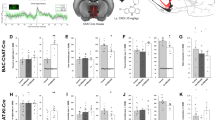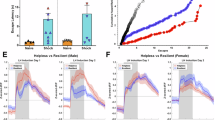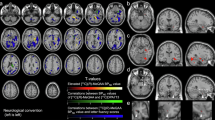Abstract
Impairments in attentional functions and capacities represent core aspects of the cognitive symptoms of schizophrenia. Attentional performance has been demonstrated to depend on the integrity and activity of cortical cholinergic inputs. The neurobiological, behavioral, and cognitive effects of repeated exposure to psychostimulants model important aspects of schizophrenia. In the present experiment, prefrontal acetylcholine (ACh) release was measured in attentional task-performing and non-performing rats pretreated with an escalating dosing regimen of amphetamine (AMPH) and following challenges with AMPH. In non-performing rats, pretreatment with AMPH did not affect the increases in ACh release produced by AMPH-challenges. In contrast, attentional task performance-associated increases in ACh release were attenuated in AMPH-pretreated and AMPH-challenged rats. This effect of repeated AMPH exposure on ACh release was already present before task-onset, suggesting that the loss of cognitive control that characterized these animals' performance was a result of cholinergic dysregulation. The findings indicate that the demonstration of repeated AMPH-induced dysregulation of the prefrontal cholinergic input system depends on interactions between the effects of repeated AMPH exposure and cognitive performance-associated recruitment of this neuronal system. Repeated AMPH-induced disruption of prefrontal cholinergic activity and attentional performance represents a useful model to investigate the cholinergic mechanisms contributing to the cognitive impairments of schizophrenia.
Similar content being viewed by others
Log in or create a free account to read this content
Gain free access to this article, as well as selected content from this journal and more on nature.com
or
References
Abi-Dargham A, Gil R, Krystal J, Baldwin RM, Seibyl JP, Bowers M et al (1998). Increased striatal dopamine transmission in schizophrenia: confirmation in a second cohort. Am J Psychiatry 155: 761–767.
Arnold HM, Bruno JP, Sarter M (2003). Assessment of sustained and divided attention in animals. In: Crawley JN, Gerfen CR, Rogawski MA, Sibley DR, Skolnick P, Wray S (eds). Current Protocols in Neuroscience. John Wiley & Sons: New York. pp 8.5E.1–8.5E.13.
Arnold HM, Burk JA, Hodgson EM, Sarter M, Bruno JP (2002). Differential cortical acetylcholine release in rats performing a sustained attention task versus behavioral control tasks that do not explicitly tax attention. Neuroscience 114: 451–460.
Arnold HM, Fadel J, Sarter M, Bruno JP (2001). Amphetamine-stimulated cortical acetylcholine release: role of the basal forebrain. Brain Res 894: 74–87.
Bell DS (1965). Comparison of amphetamine psychosis and schizophrenia. Br J Psychiatry 111: 701–707.
Bell DS (1973). The experimental reproduction of amphetamine psychosis. Arch Gen Psychiatry 29: 35–40.
Berntson GG, Sarter M, Cacioppo JT (2003a). Ascending visceral regulation of cortical affective information processing. Eur J Neurosci 18: 2103–2109.
Berntson GG, Shafi R, Knox D, Sarter M (2003b). Blockade of epinephrine priming of the cerebral auditory evoked response by cortical cholinergic deafferentation. Neuroscience 116: 179–186.
Braff DL (1993). Information processing and attention dysfunctions in schizophrenia. Schizophr Bull 19: 233–259.
Braff DL, Light GA (2004). Preattentional and attentional cognitive deficits as targets for treating schizophrenia. Psychopharmacology (Berlin) 174: 75–85.
Braver TS, Barch DM, Cohen JD (1999). Cognition and control in schizophrenia: a computational model of dopamine and prefrontal function. Biol Psychiatry 46: 312–328.
Bruno JP, Sarter M, Moore Arnold H, Himmelheber AM (1999). In vivo neurochemical correlates of cognitive processes: methodological and conceptual challenges. Rev Neurosci 10: 25–48.
Castner SA, Goldman-Rakic PS (1999). Long-lasting psychotomimetic consequences of repeated low-dose amphetamine exposure in rhesus monkeys. Neuropsychopharmacology 20: 10–28.
Castner SA, Goldman-Rakic PS (2003). Amphetamine sensitization of hallucinatory-like behaviors is dependent on prefrontal cortex in nonhuman primates. Biol Psychiatry 54: 105–110.
Crider A, Solomon PR, McMahon MA (1982). Disruption of selective attention in the rat following chronic d-amphetamine administration: relationship to schizophrenic attention disorder. Biol Psychiatry 17: 351–361.
Crombag HS, Gorny G, Li Y, Kolb B, Robinson TE (2005). Opposite effects of amphetamine self-administration experience on dendritic spines in the medial and orbital prefrontal cortex. Cereb Cortex 15: 341–348.
Crook JM, Tomaskovic-Crook E, Copolov DL, Dean B (2000). Decreased muscarinic receptor binding in subjects with schizophrenia: a study of the human hippocampal formation. Biol Psychiatry 48: 381–388.
Crook JM, Tomaskovic-Crook E, Copolov DL, Dean B (2001). Low muscarinic receptor binding in prefrontal cortex from subjects with schizophrenia: a study of Brodmann's areas 8, 9, 10, and 46 and the effects of neuroleptic drug treatment. Am J Psychiatry 158: 918–925.
Dalley JW, McGaughy J, O'Connell MT, Cardinal RN, Levita L, Robbins TW (2001). Distinct changes in cortical acetylcholine and noradrenaline efflux during contingent and noncontingent performance of a visual attentional task. J Neurosci 21: 4908–4914.
Everitt BJ, Robbins TW (1997). Central cholinergic systems and cognition. Annu Rev Psychol 48: 649–684.
Frey PW, Colliver JA (1973). Sensitivity and responsivity measures for discrimination learning. Learn Motiv 4: 327–342.
Giorgetti M, Hotsenpiller G, Ward P, Teppen T, Wolf ME (2001). Amphetamine-induced plasticity of AMPA receptors in the ventral tegmental area: effects on extracellular levels of dopamine and glutamate in freely moving rats. J Neurosci 21: 6362–6369.
Goto Y, Grace AA (2005). Dopamine-dependent interactions between limbic and prefrontal cortical plasticity in the nucleus accumbens: disruption by cocaine sensitization. Neuron 47: 255–266.
Greenwald A, Gonzalez R, Harris R, Guthrie D (1996). Effects sizes and p-values: what should be reported and what should be replicated. Psychophysiology 33: 157–183.
Himmelheber AM, Sarter M, Bruno JP (1997). Operant performance and cortical acetylcholine release: role of response rate, reward density, and non-contingent stimuli. Cogn Brain Res 6: 23–36.
Himmelheber AM, Sarter M, Bruno JP (2000). Increases in cortical acetylcholine release during sustained attention performance in rats. Cogn Brain Res 9: 313–325.
Holland PC, Han JS, Gallagher M (2000). Lesions of the amygdala central nucleus alter performance on a selective attention task. J Neurosci 20: 6701–6706.
Huang T, Yang L, Gitzen J, Kissinger PT, Vreeke M, Heller A (1995). Detection of basal acetylcholine in rat brain microdialysate. J Chromatogr B Biomed Appl 670: 323–327.
Hyde TM, Crook JM (2001). Cholinergic systems and schizophrenia: primary pathology or epiphenomena? J Chem Neuroanat 22: 53–63.
Kapur S (2003). Psychosis as a state of aberrant salience: a framework linking biology, phenomenology, and pharmacology in schizophrenia. Am J Psychiatry 160: 13–23.
Keefe RS, Bilder RM, Harvey PD, Davis SM, Palmer BW, Gold JM et al (2006). Baseline neurocognitive deficits in the CATIE schizophrenia trial. Neuropsychopharmacology 31: 2033–2046.
Knox D, Sarter M, Berntson GG (2004). Visceral afferent bias on cortical processing: role of adrenergic afferents to the basal forebrain cholinergic system. Behav Neurosci 118: 1455–1459.
Kokkinidis L, Anisman H (1981). Amphetamine psychosis and schizophrenia: a dual model. Neurosci Biobehav Rev 5: 449–461.
Kozak R, Bruno JP, Sarter M (2006). Augmented prefrontal acetylcholine release during challenged attentional performance. Cereb Cortex 16: 9–17.
Laruelle M (2000). The role of endogenous sensitization in the pathophysiology of schizophrenia: implications from recent brain imaging studies. Brain Res Rev 31: 371–384.
Laruelle M, Abi-Dargham A (1999). Dopamine as the wind of the psychotic fire: new evidence from brain imaging studies. J Psychopharmacol 13: 358–371.
Laruelle M, Abi-Dargham A, Gil R, Kegeles L, Innis R (1999). Increased dopamine transmission in schizophrenia: relationship to illness phases. Biol Psychiatry 46: 56–72.
Laruelle M, Abi-Dargham A, van Dyck CH, Gil R, D'Souza CD, Erdos J et al (1996). Single photon emission computerized tomography imaging of amphetamine-induced dopamine release in drug-free schizophrenic subjects. Proc Natl Acad Sci USA 93: 9235–9240.
LeDuc PA, Mittleman G (1995). Schizophrenia and psychostimulant abuse: a review and re-analysis of clinical evidence. Psychopharmacology (Berlin) 121: 407–427.
Lee HJ, Youn JM, O MJ, Gallagher M, Holland PC (2006). Role of substantia nigra-amygdala connections in surprise-induced enhancement of attention. J Neurosci 26: 6077–6081.
Lieberman JA, Sheitman BB, Kinon BJ (1997). Neurochemical sensitization in the pathophysiology of schizophrenia: deficits and dysfunction in neuronal regulation and plasticity. Neuropsychopharmacology 17: 205–229.
Lu W, Wolf ME (1999). Repeated amphetamine administration alters AMPA receptor subunit expression in rat nucleus accumbens and medial prefrontal cortex. Synapse 32: 119–131.
Martinez V, Garetz R, Bernshausen M, Sarter M (2006). Subchronic administration of haloperidol or clozapine attenuates attentional impairments in animals pretreated with amphetamine. Society for Neuroscience Annual Meeting. Atlanta. Abstracts # 749.716.
Martinez V, Parikh V, Sarter M (2005). Sensitized attentional performance and Fos-immunoreactive cholinergic neurons in the basal forebrain of amphetamine-pretreated rats. Biol Psychiatry 57: 1138–1146.
McDonald RL (1964). Iatrogenic amphetamine psychosis. Am J Psychiatry 120: 1200–1201.
McGaughy J, Everitt BJ, Robbins TW, Sarter M (2000). The role of cortical cholinergic afferent projections in cognition: impact of new selective immunotoxins. Behav Brain Res 115: 251–263.
McGaughy J, Kaiser T, Sarter M (1996). Behavioral vigilance following infusions of 192 IgG-saporin into the basal forebrain: selectivity of the behavioral impairment and relation to cortical AChE-positive fiber density. Behav Neurosci 110: 247–265.
McGaughy J, Sarter M (1995). Behavioral vigilance in rats: task validation and effects of age, amphetamine, and benzodiazepine receptor ligands. Psychopharmacology (Berlin) 117: 340–357.
McGhie A, Chapman J (1961). Disorders of attention and perception in early schizophrenia. Br J Med Psychol 34: 103–117.
Moghaddam B (2002). Stress activation of glutamate neurotransmission in the prefrontal cortex: implications for dopamine-associated psychiatric disorders. Biol Psychiatry 51: 775–787.
Momiyama T, Sim JA (1996). Modulation of inhibitory transmission by dopamine in rat basal forebrain nuclei: activation of presynaptic D1-like dopaminergic receptors. J Neurosci 16: 7505–7512.
Moore H, Fadel J, Sarter M, Bruno JP (1999). Role of accumbens and cortical dopamine receptors in the regulation of cortical acetylcholine release. Neuroscience 88: 811–822.
Moore H, Sarter M, Bruno JP (1993). Bidirectional modulation of stimulated cortical acetylcholine release by benzodiazepine receptor ligands. Brain Res 627: 267–274.
Moore H, Sarter M, Bruno JP (1995a). Bidirectional modulation of cortical acetylcholine efflux by infusion of benzodiazepine receptor ligands into the basal forebrain. Neurosci Lett 189: 31–34.
Moore H, Stuckman S, Sarter M, Bruno JP (1995b). Stimulation of cortical acetylcholine efflux by FG 7142 measured with repeated microdialysis sampling. Synapse 21: 324–331.
Moore H, Stuckman S, Sarter M, Bruno JP (1996). Potassium, but not atropine-stimulated cortical acetylcholine efflux, is reduced in aged rats. Neurobiol Aging 17: 565–571.
Napier TC, Simson PE, Givens BS (1991). Dopamine electrophysiology of ventral pallidal/substantia innominata neurons: comparison with the dorsal globus pallidus. J Pharmacol Exp Ther 258: 249–262.
Neigh GN, Arnold HM, Rabenstein RL, Sarter M, Bruno JP (2004). Neuronal activity in the nucleus accumbens is necessary for performance-related increases in cortical acetylcholine release. Neuroscience 123: 635–645.
Neigh-McCandless G, Kravitz BA, Sarter M, Bruno JP (2002). Stimulation of cortical acetylcholine release following blockade of ionotropic glutamate receptors in nucleus accumbens. Eur J Neurosci 16: 1259–1266.
Nelson CL, Sarter M, Bruno JP (2000). Repeated pretreatment with amphetamine sensitizes increases in cortical acetylcholine release. Psychopharmacology (Berlin) 151: 406–415.
Newell KA, Zavitsanou K, Jew SK, Huang XF (2007). Alterations of muscarinic and GABA receptor binding in the posterior cingulate cortex in schizophrenia. Prog Neuropsychopharmacol Biol Psychiatry 31: 225–233.
Nuechterlein KH, Dawson ME, Green MF (1994). Information-processing abnormalities as neuropsychological vulnerability indicators for schizophrenia. Acta Psychiat Scand 384: 71–79.
O'Flanagan PM, Taylor RB (1950). A case of recurrent psychosis associated with amphetamine addiction. J Mental Sci 96: 1033–1036.
Passetti F, Dalley JW, O'Connell MT, Everitt BJ, Robbins TW (2000). Increased acetylcholine release in the rat medial prefrontal cortex during performance of a visual attentional task. Eur J Neurosci 12: 3051–3058.
Paulson PE, Camp DM, Robinson TE (1991). Time course of transient behavioral depression and persistent behavioral sensitization in relation to regional brain monoamine concentrations during amphetamine withdrawal in rats. Psychopharmacology (Berlin) 103: 480–492.
Paulson PE, Robinson TE (1995). Amphetamine-induced time-dependent sensitization of dopamine neurotransmission in the dorsal and ventral striatum: a microdialysis study in behaving rats. Synapse 19: 56–65.
Peterson JD, Wolf ME, White FJ (2006). Repeated amphetamine administration decreases D1 dopamine receptor-mediated inhibition of voltage-gated sodium currents in the prefrontal cortex. J Neurosci 26: 3164–3168.
Prasad BM, Sorg BA, Ulibarri C, Kalivas PW (1995). Sensitization to stress and psychostimulants. Involvement of dopamine transmission versus the HPA axis. Ann NY Acad Sci 771: 617–625.
Raedler TJ, Knable MB, Jones DW, Urbina RA, Gorey JG, Lee KS et al (2003). In vivo determination of muscarinic acetylcholine receptor availability in schizophrenia. Am J Psychiatry 160: 118–127.
Robinson TE, Becker JB (1986). Enduring changes in brain and behavior produced by chronic amphetamine administration: a review and evaluation of animal models of amphetamine psychosis. Brain Res 396: 157–198.
Robinson TE, Camp DM (1987). Long-lasting effects of escalating doses of d-amphetamine on brain monoamines, amphetamine-induced stereotyped behavior and spontaneous nocturnal locomotion. Pharmacol Biochem Behav 26: 821–827.
Robinson TE, Jurson PA, Bennett JA, Bentgen KM (1988). Persistent sensitization of dopamine neurotransmission in ventral striatum (nucleus accumbens) produced by prior experience with (+)-amphetamine: a microdialysis study in freely moving rats. Brain Res 462: 211–222.
Robinson TE, Kolb B (2004). Structural plasticity associated with exposure to drugs of abuse. Neuropharmacology 47 (Suppl 1): 33–46.
Rothman RB, Baumann MH, Dersch CM, Romero DV, Rice KC, Carroll FI et al (2001). Amphetamine-type central nervous system stimulants release norepinephrine more potently than they release dopamine and serotonin. Synapse 39: 32–41.
Sarter M, Bruno JP, Parikh V (2007). Abnormal neurotransmitter release in behavioral and cognitive disorders: toward concepts of dynamic and function-specific dysregulation. Neuropsychopharmacology (in press).
Sarter M, Gehring WJ, Kozak R (2006). More attention must be paid: the neurobiology of attentional effort. Brain Res Rev 51: 155–160.
Sarter M, Givens B, Bruno JP (2001). The cognitive neuroscience of sustained attention: where top-down meets bottom-up. Brain Res Rev 35: 146–160.
Sarter M, Hasselmo ME, Bruno JP, Givens B (2005a). Unraveling the attentional functions of cortical cholinergic inputs: interactions between signal-driven and top-down cholinergic modulation of signal detection. Brain Res Rev 48: 98–111.
Sarter M, McGaughy J (1998). Assessment of sustained and divided attention in rats: aspects of validity. Psychopharmacology (Berlin) 138: 260–262.
Sarter M, Nelson CL, Bruno JP (2005b). Cortical cholinergic transmission and cortical information processing following psychostimulant-sensitization: implications for models of schizophrenia. Schizophr Bull 31: 117–138.
Segal DS, Geyer MA, Schuckit MA (1981). Stimulant-induced psychosis: an evaluation of animal methods. In: Youdim MBH, Lovenberg W, Sharman DF, Lagnado JR (eds). Essays in Neurochemistry and Neuropharmacology, Vol 5. Wiley: Sussex, UK. pp 95–129.
Segal DS, Janowski DS (1978). Psychostimulant-induced behavioral effects: possible models of schizophrenia. In: Lipton MA, DiMascio A, Killam KF (eds). Psychopharmacology: A Generation of Progress. Raven Press: New York. pp 1113–1124.
Segal DS, Kuczenski R (1997). An escalating dose ‘binge’ model of amphetamine psychosis: behavioral and neurochemical characteristics. J Neurosci 17: 2551–2566.
Snyder SH (1973). Amphetamine psychosis: a ‘model’ schizophrenia mediated by catecholamines. Am J Psychiatry 130: 61–67.
Snyder SH, Aghajanian GK, Matthysse S (1972). Prospects for research on schizophrenia. V. Pharmacological observations, Drug-induced psychoses. Neurosci Res Program Bull 10: 430–445.
Strakowski SM, Sax KW, Setters MJ, Stanton SP, Keck Jr PE (1997). Lack of enhanced response to repeated d-amphetamine challenge in first-episode psychosis: implications for a sensitization model of psychosis in humans. Biol Psychiatry 42: 749–755.
Tenn CC, Fletcher PJ, Kapur S (2003). Amphetamine-sensitized animals show a sensorimotor gating and neurochemical abnormality similar to that of schizophrenia. Schizophr Res 64: 103–114.
Turchi J, Sarter M (1997). Cortical acetylcholine and processing capacity: effects of cortical cholinergic deafferentation on crossmodal divided attention in rats. Cogn Brain Res 6: 147–158.
Turchi J, Sarter M (2000). Cortical cholinergic inputs mediate processing capacity: effects of 192 IgG-saporin-induced lesions on olfactory span performance. Eur J Neurosci 12: 4505–4514.
Vanderschuren LJ, Beemster P, Schoffelmeer AN (2003). On the role of noradrenaline in psychostimulant-induced psychomotor activity and sensitization. Psychopharmacology (Berlin) 169: 176–185.
Vanderschuren LJ, Schmidt ED, De Vries TJ, Van Moorsel CA, Tilders FJ, Schoffelmeer AN (1999). A single exposure to amphetamine is sufficient to induce long-term behavioral, neuroendocrine, and neurochemical sensitization in rats. J Neurosci 19: 9579–9586.
Venables PH (1964). Input dysfunction in schizophrenia. In: Maher BA (ed). Progress in Experimental Personality Research. Academic Press: New York. pp 1–47.
Ventura J, Nuechterlein KH, Lukoff D, Hardesty JP (1989). A prospective study of stressful life events and schizophrenic relapse. J Abnorm Psychol 98: 407–411.
Wallis GG, Mc HJ, Scott OC (1949). Acute psychosis caused by dextro-amphetamine. Br Med J 2: 1394.
Weiner IB (1964). Differential diagnosis in amphetamine psychosis. Psychiatr Q 38: 707–716.
Yui K, Goto K, Ikemoto S, Ishiguro T, Angrist B, Duncan GE et al (1999). Neurobiological basis of relapse prediction in stimulant-induced psychosis and schizophrenia: the role of sensitization. Mol Psychiatry 4: 512–523.
Zaborszky L (2002). The modular organization of brain systems. Basal forebrain: the last frontier. Prog Brain Res 136: 359–372.
Zaborszky L, Gaykema RP, Swanson DJ, Cullinan WE (1997). Cortical input to the basal forebrain. Neuroscience 79: 1051–1078.
Zahm DS (2000). An integrative neuroanatomical perspective on some subcortical substrates of adaptive responding with emphasis on the nucleus accumbens. Neurosci Biobehav Rev 24: 85–105.
Zmarowski A, Sarter M, Bruno JP (2005). NMDA and dopamine interactions in the nucleus accumbens modulate cortical acetylcholine release. Eur J Neurosci 22: 1731–1740.
Acknowledgements
Rouba Kozak is now at Pfizer Pharmaceuticals (Ann Arbor), and Holden Brown is at the University of Illinois (Chicago). The authors' research was supported by PHS Grants MH 063114, NS37026 (MS, JPB), MH057436 (JPB, MS) and KO2 MH01072 (MS). Damon Young was supported by a Predoctoral Fellowship from the Ford Foundation and Vicente Martinez by an Interdisciplinary Research Training Grant in Substance Abuse (T32 DA007267-12; University of Michigan Substance Abuse Research Center; UMSARC).
Author information
Authors and Affiliations
Corresponding author
Rights and permissions
About this article
Cite this article
Kozak, R., Martinez, V., Young, D. et al. Toward a Neuro-Cognitive Animal Model of the Cognitive Symptoms of Schizophrenia: Disruption of Cortical Cholinergic Neurotransmission Following Repeated Amphetamine Exposure in Attentional Task-Performing, but Not Non-Performing, Rats. Neuropsychopharmacol 32, 2074–2086 (2007). https://doi.org/10.1038/sj.npp.1301352
Received:
Revised:
Accepted:
Published:
Issue date:
DOI: https://doi.org/10.1038/sj.npp.1301352
Keywords
This article is cited by
-
Understanding translational research in schizophrenia: A novel insight into animal models
Molecular Biology Reports (2023)
-
MAM (E17) rodent developmental model of neuropsychiatric disease: disruptions in learning and dysregulation of nucleus accumbens dopamine release, but spared executive function
Psychopharmacology (2015)
-
Modes and Models of Forebrain Cholinergic Neuromodulation of Cognition
Neuropsychopharmacology (2011)
-
Enhancement of Attentional Performance by Selective Stimulation of α4β2* nAChRs: Underlying Cholinergic Mechanisms
Neuropsychopharmacology (2010)
-
Disruption of Mesolimbic Regulation of Prefrontal Cholinergic Transmission in an Animal Model of Schizophrenia and Normalization by Chronic Clozapine Treatment
Neuropsychopharmacology (2009)



